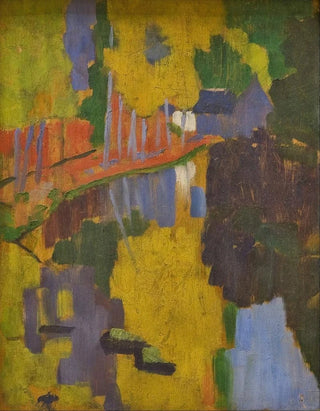Art print | The Talisman - Paul Sérusier


View from behind

Frame (optional)
Reproduction of The Talisman - Paul Sérusier – Captivating Introduction
In the vast panorama of art history, some works transcend their era to become symbols of a movement, a thought, or an emotion. "The Talisman" by Paul Sérusier is undoubtedly one of these works. Painted in 1888, it embodies the very essence of synthetism, an artistic approach that seeks to capture the spirit of a scene through simplified forms and vibrant colors. By examining this piece, the viewer is immediately transported into a universe where nature and imagination intertwine, revealing a poetic vision of the world. The art print of "The Talisman - Paul Sérusier" allows for appreciation of this visual alchemy, while offering a window into the artist's soul.
Style and uniqueness of the work
The piece stands out for its bold use of color and harmonious composition. Sérusier, influenced by the emerging Fauvism, chooses vivid and non-realistic hues to express his emotions and impressions. The forms are stylized, almost abstract, giving "The Talisman" a mystical dimension. The landscape, though recognizable, is distorted through the prism of the artist's sensitivity, creating an atmosphere that is both familiar and enigmatic. The flowing lines and juxtaposition of vibrant colors invite deep contemplation, where each detail seems charged with meaning. This work does not merely depict nature; it captures its essence, magic, and spirituality, thus offering a novel visual experience.
The artist and his influence
Paul Sérusier is an emblematic figure of the Nabis movement, a group of artists advocating an intuitive and personal approach to art. His stay in Pont-Aven, Brittany, was decisive in his artistic development. It was there that he met Paul Gauguin, whose innovative ideas on color and composition would profoundly influence his work. Sérusier, through his boldness and vision, paved the way for many artists who followed, influencing generations of modern painters. His approach to color as a means of emotional expression has

Matte finish

View from behind

Frame (optional)
Reproduction of The Talisman - Paul Sérusier – Captivating Introduction
In the vast panorama of art history, some works transcend their era to become symbols of a movement, a thought, or an emotion. "The Talisman" by Paul Sérusier is undoubtedly one of these works. Painted in 1888, it embodies the very essence of synthetism, an artistic approach that seeks to capture the spirit of a scene through simplified forms and vibrant colors. By examining this piece, the viewer is immediately transported into a universe where nature and imagination intertwine, revealing a poetic vision of the world. The art print of "The Talisman - Paul Sérusier" allows for appreciation of this visual alchemy, while offering a window into the artist's soul.
Style and uniqueness of the work
The piece stands out for its bold use of color and harmonious composition. Sérusier, influenced by the emerging Fauvism, chooses vivid and non-realistic hues to express his emotions and impressions. The forms are stylized, almost abstract, giving "The Talisman" a mystical dimension. The landscape, though recognizable, is distorted through the prism of the artist's sensitivity, creating an atmosphere that is both familiar and enigmatic. The flowing lines and juxtaposition of vibrant colors invite deep contemplation, where each detail seems charged with meaning. This work does not merely depict nature; it captures its essence, magic, and spirituality, thus offering a novel visual experience.
The artist and his influence
Paul Sérusier is an emblematic figure of the Nabis movement, a group of artists advocating an intuitive and personal approach to art. His stay in Pont-Aven, Brittany, was decisive in his artistic development. It was there that he met Paul Gauguin, whose innovative ideas on color and composition would profoundly influence his work. Sérusier, through his boldness and vision, paved the way for many artists who followed, influencing generations of modern painters. His approach to color as a means of emotional expression has






